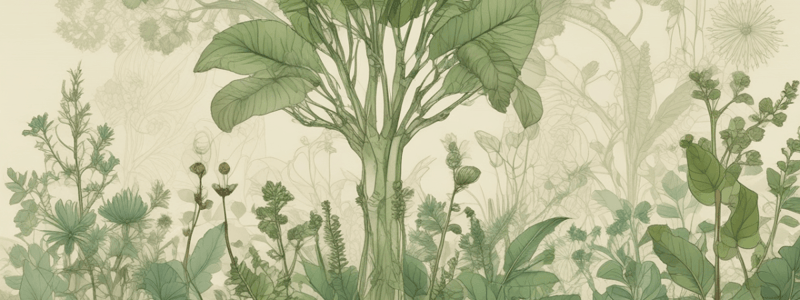Podcast
Questions and Answers
What is the primary function of the palisade layer?
What is the primary function of the palisade layer?
- To store products of photosynthesis
- To conduct cellular respiration and photosynthesis (correct)
- To facilitate gas exchange through stomata
- To regulate water loss and carbon dioxide absorption
What is the main function of the spongy layer?
What is the main function of the spongy layer?
- To conduct cellular respiration
- To store products of photosynthesis
- To regulate water loss and carbon dioxide absorption
- To facilitate gas exchange through stomata (correct)
What is the function of the xylem in vascular bundles?
What is the function of the xylem in vascular bundles?
- To transport nutrients and organic compounds from leaves to the rest of the plant
- To move water throughout the plant (correct)
- To store products of photosynthesis
- To regulate gas exchange through stomata
What is the role of guard cells in stomata?
What is the role of guard cells in stomata?
What is the primary function of the upper epidermis?
What is the primary function of the upper epidermis?
What is the mesophyll composed of?
What is the mesophyll composed of?
What is the function of the lower epidermis?
What is the function of the lower epidermis?
What is the characteristic of the cells in the palisade layer?
What is the characteristic of the cells in the palisade layer?
What is the main function of the cuticle layer?
What is the main function of the cuticle layer?
Which layer of the leaf is responsible for absorbing sunlight?
Which layer of the leaf is responsible for absorbing sunlight?
What is the primary location of chloroplasts in photosynthetic plants?
What is the primary location of chloroplasts in photosynthetic plants?
Why is the cuticle layer thicker in arid climates?
Why is the cuticle layer thicker in arid climates?
What is the primary function of leaves in plants?
What is the primary function of leaves in plants?
Which of the following is NOT a function of the cuticle layer?
Which of the following is NOT a function of the cuticle layer?
What is the term for the process by which plants produce energy from light?
What is the term for the process by which plants produce energy from light?
Flashcards are hidden until you start studying
Study Notes
Photosynthesis in Leaves
- Plants are autotrophic organisms that produce their own energy through photosynthesis.
- Chlorophyll, the light-capturing pigment, is found in chloroplasts, which are primarily located in leaves.
Layers of a Leaf
- A leaf consists of several layers that work together to facilitate photosynthesis.
- The layers include the cuticle layer, upper epidermis, palisade layer, spongy layer, lower epidermis, and stomata.
Cuticle Layer
- The cuticle layer is a waxy layer that protects the leaf from water loss and physical/chemical damage.
- It controls the entrance and exit of carbon dioxide and oxygen from the leaf's surface.
- The cuticle layer adapts to different climates, becoming thicker in dry climates and thinner in moist climates.
Upper Epidermis
- The upper epidermis consists of a thin layer of cells that allow sunlight to pass through.
- It helps prevent excessive water loss and regulates carbon dioxide and oxygen absorption.
- Cells in this layer do not possess chloroplasts, where photosynthesis takes place.
Palisade Layer
- The palisade layer consists of columnar cells where most photosynthesis occurs.
- These cells are tightly packed together to absorb sunlight and produce energy.
- Chloroplasts in the palisade layer convert carbon dioxide into cellular energy.
Spongy Layer
- The spongy layer consists of irregularly shaped cells that facilitate the diffusion of nutrients and gases.
- It works with the stomata to control gas exchange and stores products of photosynthesis.
- The spongy layer contains vascular bundles responsible for transporting nutrients throughout the plant.
Lower Epidermis
- The lower epidermis is a continuation of the epidermal cells on the upper surface of the leaf.
- It secretes the waxy substance associated with the cuticle layer and facilitates gas exchange via stomata.
Stomata
- Stomata are pores in the lower epidermis where gas exchange occurs.
- Guard cells, which contain chloroplasts, surround each stomata and regulate its opening and closing.
- Guard cells respond to changes in light, hydration, and temperature to control nutrient and gas exchange.
Studying That Suits You
Use AI to generate personalized quizzes and flashcards to suit your learning preferences.




